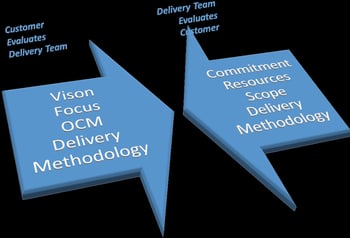Sooner or later every organization is faced with a project in trouble. Most times we find out when the money is gone or when it’s too late to do anything beyond surviving the outcome. Very often project sponsors see project reporting as a routine process that only requires selecting the right project manager. Experience tells us this perception is far from valid.
- Good projects led by strong project managers sometimes go bad
- Project Managers are under tremendous pressure to show progress
- Most reporting is after a problem surfaces, rather than leading in anticipation of a problem
- In large projects and multi-project programs, key communications and expectations are often missed or misinterpreted
These realities led us to develop a new two-phase approach to look at project health/status reporting that goes beyond the typical, cost, schedule, and issue reporting.
The first step is to apply a type of 360° assessment to strategic projects. In this approach, input is collected from key project players – half on the management or customer side and half on the in-house or contracted integration or project delivery side. Weekly input is collected anonymously. Each factor is rated on a simple scale from poor to excellent.

The weekly collection is displayed in a dashboard that allows decision makers to look at trends that anticipate current and emerging issues. The cross section and anonymous nature of inputs removes the bias towards looking successful.
Our second phase aligns expectations in order to ensure everyone on the team is on the same page. This step addresses the critical communication of expectations within the project team and betw een the project team and key stakeholders.
een the project team and key stakeholders.
Our purpose is not to perfect the expectations between all members of a large team as the number of combinations would become unmanageable. We want to:
- Identify the key relationships (e.g. Sponsor to Project Manager; Project Manager to Technical Lead, Architect, or Process Analyst; etc.)
- Identify areas of misalignment and take corrective action at project initiation, key milestones and in response to issues raised through “Pulse Checks” mentioned above
- Coach each stakeholder to develop specific and measurable expectations of others and what they think is expected of them for identified areas of misalignment
- Analyze results to identify the largest misalignments
- Feedback the results to the Project Stakeholders and develop an action plan to resolve expectation differences
This two phase approach moves project reporting from a rehash of what has happened to a dynamic look at the drivers of project success. It will enable decision makers to anticipate problems and when required, develop a blueprint to full project recovery.
In terms of overall project delivery, project controls and health checks are one part of t he project delivery process, which also includes steps required to initiate, plan, execute, and close. Success in all areas requires strong and systematic project management to ensure delivery that meets requirements within budget and on-time. For projects that require a change in behavior beyond product delivery, we strongly believe emphasis needs to be placed on organization change management to assure realization of measureable business value.
he project delivery process, which also includes steps required to initiate, plan, execute, and close. Success in all areas requires strong and systematic project management to ensure delivery that meets requirements within budget and on-time. For projects that require a change in behavior beyond product delivery, we strongly believe emphasis needs to be placed on organization change management to assure realization of measureable business value.
Let us know how you view this approach and if it would work in your organization by completing the form below or by contacting me directly at tholtz@tbointl.com.
1.PMI.org





